High fidelity prototyping has now become a popular term in the world of product design and development as it is like a bridge between ideation and execution. In prototyping the word “fidelity ” means representing the final product with details . As many prototypes are unable to provide high fidelity experience, prototypes with high fidelity have a great impact in the product design and testing sector of the digital world . To be very specific, high fidelity prototyping is based on computers .
For this reason, a section of people are very interested in learning more about this and they often do research on “High Fidelity Prototyping” because the information they gather through research will help them take careful steps towards implementation. Thinking about this fact, in this blog we are going to explain the major key factors related to high fidelity prototyping which are – Definition of high fidelity prototyping , advantages as well as disadvantages. So let us begin –
Definition of high fidelity prototyping –
Knowing the definition of high fidelity prototyping is the most basic as well as important key factor among all. It is defined as an advanced presentation made digitally by using some software. These prototypes nearly imitate the appearance of the final product by focusing the functionality and user interactions. It contains exact dimensions and design elements and aims to provide user experience like real. “High Fidelity Prototyping” is also called hi-fi prototyping.
Advantages of High Fidelity Prototyping-
After knowing the definition, the second essential thing is to know about its advantages. The advantages of high fidelity prototyping are given below –
1. Advance User Experience :
It allows the designers to make the final product representation with interactive and visually appealing user interactions. It also enables simulating the look and functionality of the final product. With its use the designers can recognize the error related to usability and with its help the designers can wisely take their decisions to increase the user experience which leads the way to maximum user satisfaction.
2. Reliable for user testing :
This gives a similar feeling as the final product and also the users are able to navigate through it . By the help of this the designers will be able to collect data on the preference of actual human performance.
3. Efficient in Communication:
This type of comprehensive prototyping acts as an usual visual language to communicate with the idea of design as well as create functional communication between designers, developers and stakeholders. It gives the stakeholders a tangible presentation of the final product by giving a realistic depiction of the design vision. So with the help of high fidelity prototyping , the designers are able to collect valuable feedback from stakeholders and developers which may prove beneficial for them to collaborate in the entire development process.
4. Time saving :
High fidelity prototyping is able to identify the flaws in the design procedure which can save precious times of the designers. Except for this prototyping , the designers need to use detailed prototypes which can cost daily revisions and that can be a reason for slowing up the development cycle. So , saving time is really a good quality of it.
5. Reducing risks :
With confirmation of design ideas and its benefits in the basic step, this prototyping will guide to reduce the risk of cost. As it includes iterative testing, the designers may recognize the possible error and they can solve the error before it turns into a large one . This active procedure not only decreases the risks but also saves the funds related to the designs.
Disadvantages of High Fidelity Prototyping-
Every single thing has its advantages and disadvantages and so goes with it also. Check out below to know the disadvantages about it :
– Needs exceptional investment in time and funds.
– Required particular software which may demand additional costs.
– This sector is eligible for skilled designers in comparison to beginners .
– insufficient in flexibility and hinder designers’ ability
– Take a huge time if required notable changes with heavy interactive elements .
– Sometimes users may mistake the prototypes as a final product
– Always have possibility of destroying by bugs
– Possible to create misconception between developers and stakeholders.
– Sometimes create overemphasis on visually appealing prototypes.
– Restricted in accessibility and full of technical limitations.
– Sometimes mistakenly create the wrong impression about the final product.
Coming to the termination of the blog , this prototyping recommends a vast number of advantages like – Advance User Experience, Reliable for user testing , Efficient in Communication, Time saving and Reducing risks. But with these benefits it also comes with a number of disadvantages which is enough to challenge the decisions of the designers. As the technology continuously progresses day by day , the importance of this prototyping will continue to grow to deliver user-centric solutions . However knowing its disadvantages the designers should think carefully and wisely take decisions according to the situation and their requirements.




